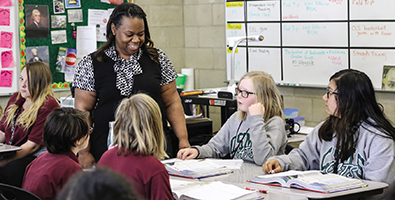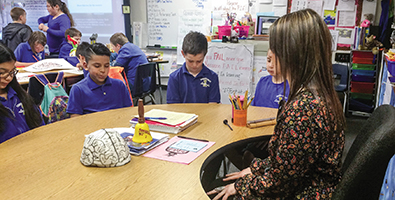The School Climate Connection With SEL
Type:
Article
September 01, 2018
Nevada's Washoe County applies a systemwide strategy for targeting early on those most at risk

The Washoe County School District encompasses 6,500 square miles of northern Nevada, including the cities of Reno and Sparks. More than 64,000 students attend our 103 schools, and with 8,000-plus employees, we are the largest employer in the area. Our students reflect our diverse, majority-minority population, and 45 percent of them live in poverty. Our community is transient and experiencing rapid growth due to an influx of companies drawn by the state’s welcoming attitude toward new business.
As a district, we are committed, as our motto proclaims, to helping “Every Child, By Name and Face, to Graduation.” Our district achieved a record-high graduation rate in 2017 of 84 percent, an increase of seven percentage points over the previous year. We are making major strides to our goal of achieving a districtwide 90 percent by 2020 — “90 by 20.”
But it took concentrated effort over time to reach this point.
A District Priority
In 2012, with our graduation rate dipping to 66 percent, Washoe County was among eight urban school districts awarded a grant to implement social and emotional learning across the district. This pioneering work was funded
through the NoVo Foundation and led by the Collaborative for Academic, Social and Emotional Learning, or CASEL.Even as district leadership changed — Heath Morrison left as superintendent in early summer in 2012 and was succeeded by Pedro Martinez — our commitment never wavered. In adopting this new way of supporting our students, we created what became known as “The Washoe Way,” a unique approach to implementing and sustaining educational reforms.
Under The Washoe Way, SEL was incorporated not just at the school level, but as a dynamic, districtwide strategy to raise the graduation rate and improve academic outcomes for all students at every level. We included SEL in our strategic plan, professional development, professional growth and evaluations, accountability, and school improvement plans. Our school board was an enthusiastic partner in this effort and regularly received updates about our progress.
SEL quickly became a district priority, working in support of our four fundamentals: core curriculum and instruction; inclusive practice; climate and engagement; and multi-tiered system of supports, or MTSS.
District staff member Trish Shaffer, who previously served as MTSS coordinator, was assigned to lead the SEL effort, and she now serves as the MTSS/SEL coordinator. Staff members at 12 schools agreed to become the first wave of employees trained in SEL implementation. Teacher ambassadors returned from training to instruct their co-workers and counterparts about the new practices, a train-the-trainer effort that proved both efficient and effective.
In 2012, Washoe County developed a multiyear plan to provide SEL to all students in all schools. By 2016, SEL teams from every one of our 93 schools had training and coaching. Today, SEL has become integrated into the fabric of many schools’ daily practice in the Washoe County School District.
Launching Pad
In 2009, we began using an Early Warning Risk Index in 9th grade to identify students at no, low, moderate or high risk to not graduate on time based on their attendance, personal behaviors and course attainment. The index is a strong predictor of graduation. Only 31 percent of students who were high risk in 9th grade graduated on time compared to 89 percent of no-risk 9th-grade students.This was a concern, indicating we needed to identify and support students far earlier in their educational pathway. But it also indicated how resilient that 31 percent of high-risk 9th graders were, and it led us to wonder whether those students might have had social and emotional skills that the other 69 percent did not. If we built those resiliencies among all students, would our graduation outcomes improve?
Beginning with the first SEL implementation in our classrooms, we continue to use data to determine where our students thrive and where they struggle. We conduct annual climate surveys among students in grades 5-9 and in grade 11, in part to determine how students themselves rate the ease or difficulty of different social and emotional competencies. We developed this assessment in collaboration with CASEL and gathered more than 100 students into focus groups to collect their feedback on whether the competencies we surveyed resonated with their school experiences.
As a result, we adjusted language in the next round of surveys to make it more understandable and relatable to our students in order to achieve a more accurate assessment of the curricula impact. Our data team compares this feedback to academic and behavioral data to build a more holistic student profile, which in turn guides our future planning for the program.
For instance, we ask students to rate the difficulty of several relationship competencies from “very difficult” to “very easy,” including:

Joining a group
I do not usually sit with at lunch;Talking to an adult when I have problems at school; and
» Introducing myself to a new student at school.
Survey results are shared with students during a Student Data Summit, where students present the data to other students, ask questions, express concerns and provide information to administrative staff on how their schools measure up in these crucial areas. We post the results of this survey publicly at www.wcsddata.net to allow for more transparent conversations with the community about our approach to social and emotional learning and the data we receive from students.
Monitoring Risks
Knowing and monitoring risk factors can help us direct more SEL services and supports to these students whose chances of graduation are compromised, and we continue to refine our data tools to identify these students earlier.The NoVo Foundation, in collaboration with CASEL, provides financial resources, ongoing guidance and funding for two consultants, and continues to support the implementa-tion in Washoe County. CASEL, working in partnership with NoVo, also sponsored cross-district learning events that drew representatives from across the country who learned from our programs, processes and implementations.
SEL plays a prominent role in our district goals, including our “90 by 20” graduation goal. Our district recognizes that academics do not tell the whole story. Students need to be emotionally and socially equipped to deal with an increasingly challenging world, and SEL provides them with these essential skills.
Achieving Success
When I became acting superintendent of the Washoe County School District in 2014 and was named superintendent the following year, I pledged to continue our SEL journey. I have seen firsthand how our academic outcomes have improved. Our graduation rates have risen to 84 percent, an 18-percentage point increase in six years.Students with higher social and emotional competencies in Washoe County have reduced suspension rates, improved GPAs and improved attendance. Anecdotally, teachers note that students have increased abilities to manage stress and depression and better attitudes about themselves, others and school. The program is cost-effective, as research conducted by Teachers College at Columbia University showed that every dollar invested in SEL programming yields an $11 return in long-term benefits, including better mental and physical health, reduced juvenile crime and higher lifetime earnings.
Our school district will continue to use SEL to achieve success for all of our students.
Author
Advertisement
Advertisement
Advertisement
Advertisement




